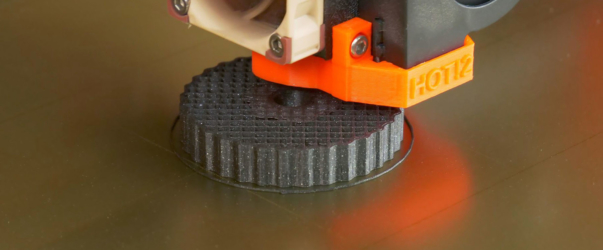What is 3D Print?
3D printing is also called additive manufacturing, a process of making three dimensional solid objects from a digital file by successively adding material, layer by layer, in order to produce complex shapes using less material than traditional manufacturing methods.
It’s actually the opposite of subtractive manufacturing, conventional machining, casting and forging processes, where material is removed from a stock item or poured into a mold and shaped by means of dies, presses and hammers.
Types of 3D Printing Technology
There are several types of 3D printing technologies, all of them are similar as they construct an object layer by layer in order to create complex shapes (check more info about each one in PenandPlastic Blog):

Picture by Prusa
- Fused deposition modelling (FDM)
- Stereolithography(SLA)
- Digital Light Processing(DLP)
- Selective Laser Sintering (SLS)
- Selective laser melting (SLM)
- Laminated object manufacturing (LOM)
- Digital Beam Melting (EBM)
We use the FDM – Fused deposition modelling, this process works by melting material and extruding it through a nozzle to 3D print a cross section of an object each layer at a time. The bed moves for each new layer and this process repeats until the object is completed.
It was chosen for it’s very good ratio between investment, reliability, end product quality, and agility by accepting a very wide range of filament types.
3D Print Materials
Several types of materials can be used in additive manufacturing like polymers, metals, concrete, ceramics, paper and certain edibles (e.g. chocolate). There are commonly produced in the form of a filament, powder or liquid resin.
Our products are mainly made with ASA polymer (Acrylonitrile Styrene Acrylate), a tougher brother of ABS (Acrylonitrile Butadiene Styrene), with higher rigidity and ten times greater resistance against weathering and UV radiation.

Design and print by Maxa with ASA Extrafill “Traffic Black” from Fillamentum.
It’s also a lot more resistance to high temperatures, without deformation while using in hot sunny days, or when stored inside the car. It can retain it’s colour and mechanical properties of high impact resistance even after prolonged outdoor exposure, exhibiting a greater resistance to environmental stress cracking than ABS.
All these characteristics are mandatory when we want to produce the best combat sports gear.
“ASA vs ABS
So, how exactly do the two materials compare?
The tensile strength of ASA Extrafill is 40 MPa, with 35% elongation at break, and a flexural strength of 62 MPa.
ABS Extrafill, by comparison, has a slightly lower tensile strength of 32/39 MPa, 20% elongation at break and 60 MPa flexural strength.
The thermal properties of ASA are also superior to ABS. Fillamentum ASA Extrafill typically distorts at temperatures of 86/96 ºC (1.8 MPa verses 0.45 MPa test conditions), whereas ABS has a heat deflection temperature up to 81 ºC.
When printing, ASA Extrafill has strong interlayer adhesion, lower comparable warping than ABS, and fewer styrene emissions. It is also a recyclable material.”
Source: 3dprintingindustry.com
You can also check the detailed and scientific tests of CNC Kitchen where the pros of ASA filament are well seen, specially taking in mind the outdoor and paintball abusive use!
Production Methodology
Several months were spent in the background in order to calibrate, perfect and master the very hard art of ASA printing. It’s a special filament that requires a lot of tuning and patience to get it right where we wanted it.

That whole effort was not just for the visual quality of the print, but mainly to ensure it’s structural precise and robust to be able to endure it’s use on a game field, with it’s normal “bumpy rides”. These are mere words that translate hundreds of hours printing several types of structures and tuning accordingly the result.

Field tests followed, were several players had the chance to try it out several versions and provide a fantastic feedback, that allowed several revisions and add-ons. For some products this whole process took 6 to 8 months, in order to prevent field flaws, but also to avoid launching several versions along the year.
